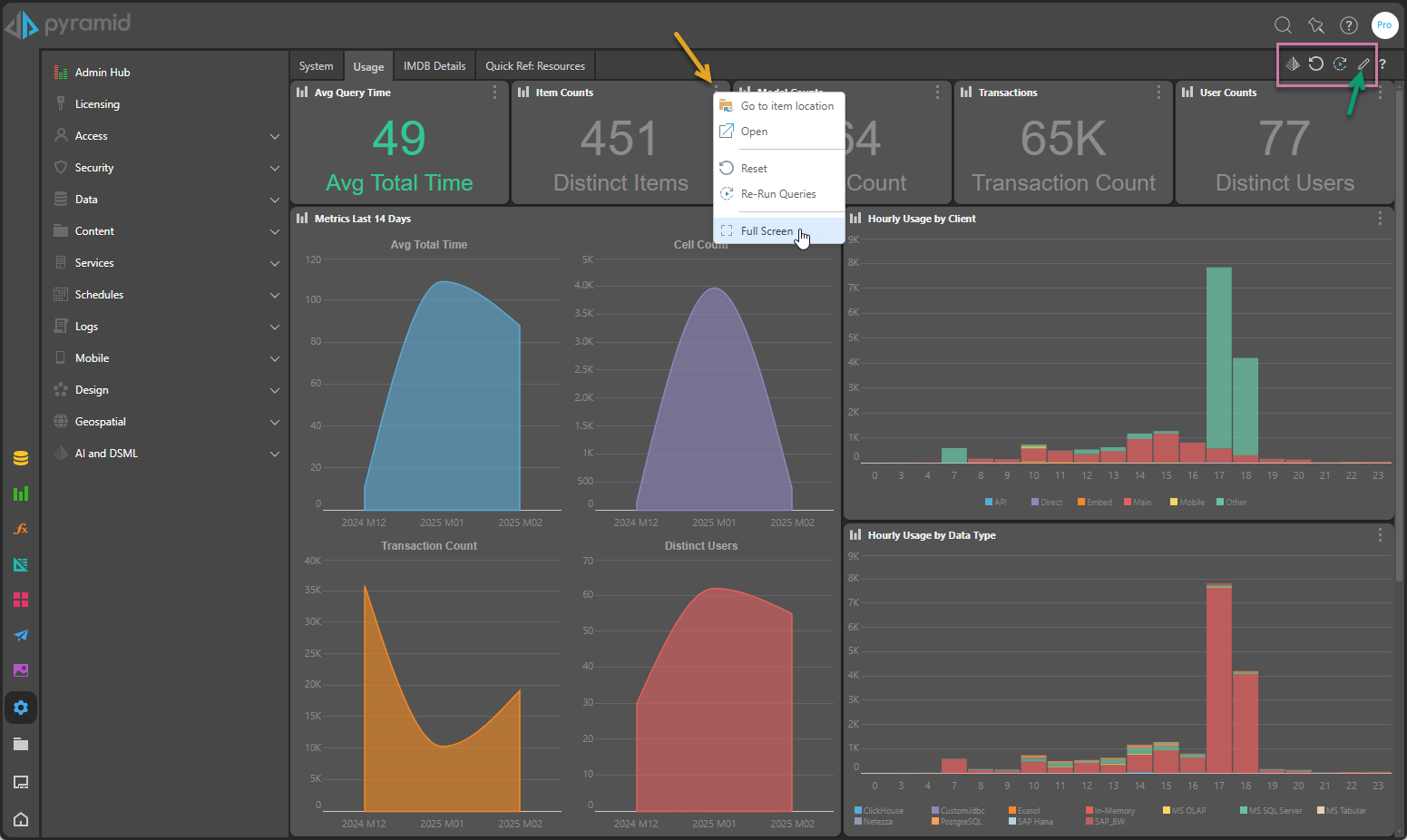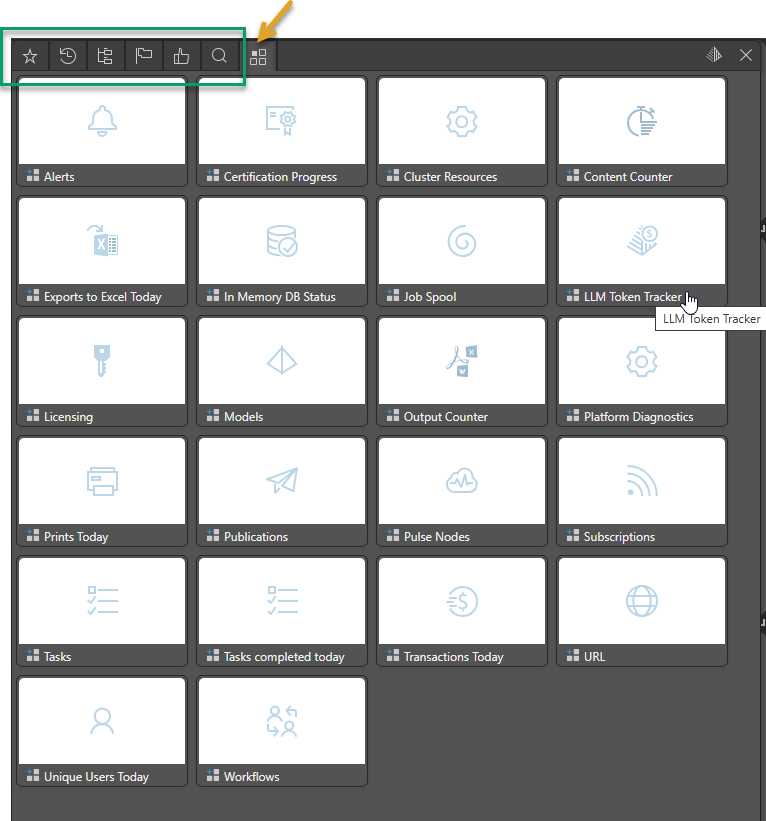The Admin Hub is the customizable home page for the Admin Console. It features tabs and tiles that display the topology of the services in the Pyramid cluster including high-level diagnostic data, a summary of the current licensing, pulse nodes, task status, and so on, and embedded discoveries and presentations. The Admin Hub is a good way to share your organization's Pyramid usage data.
- Click here to learn how to create and manage Hub Templates.
Admin Hub Content

Content Types
The Admin Hub can display the following types of content:
- Widget Presets: A selection of pre-designed widgets featuring high-level diagnostic information.
- Discoveries and Presentations: Discoveries and presentations can be added directly to the Hub.
Customizing the Admin Hub
You can customize your own view of the Admin Hub as needed; your edits will not be visible to other users. The widgets used to edit the contents are at the top-right of the page (purple highlight above):
- Embedded Search: Use the Chatbot to create and embed a new discovery in your Hub. For more information, see Embedded Search.
- Reset All: Reset all items in the hub to their most recently saved state, discarding any changes or interactions applied from the hub.
- Rerun Queries: Run all queries in the hub.
- Edit: Edit the hub template. For more information, see Opening the Admin Hub Editor.
Tip: You can also access options for each of your tiles from the ellipse at the top-right of each (orange arrow above).
Opening the Admin Hub Editor
From the Home page:
- Click Edit (green arrow above).
This puts your Hub into Edit mode, so that you can manage and customize the tabs, content items, and so on that appear in your hub. Note the changes to the controls that are available in Edit mode:

Editing your tabs
Use the options on the tabs themselves (left-hand side) to manage your tabs:
- To add a new tab, click Add Tab (blue arrow above).
- To rename your tab, click the current name and then edit it directly.
- To change the sequence of your tabs, drag the Handle (orange arrow above) to reposition each tab as needed.
- To delete a tab, click its Close (X) icon.
Editing the content of a tab
Use the macro buttons (green highlight above) at the top-right of the page to add content to your currently selected tab and to save your changes:

- Embedded Search: Use the Chatbot to create and embed a new discovery in your Hub. For more information, see Embedded Search.
- Add Content or Widget: Add a discovery, presentation, or widget preset to your tab (yellow arrow above). For more information, see Add content or widget.
- Reset: Discard any changes and revert to the default user hub (green arrow above). The default layout is the layout defined by the Hub Template without any of your customizations.
- Save: Save changes to all tabs and exit edit mode (purple arrow above).
- Cancel: Discard all changes and exit edit mode (black arrow above).
Embedded Search
You can make use of the Embedded Search facility (blue arrow above) in either the Edit or View page. The Embedded Search button opens a text field where you can describe a discovery that you would like to build and add to your Hub. The Chatbot then builds the discovery as you described it and, if you click Add To Hub, saves it and embeds it in the Hub.
- Click here to learn how to use Embedded Search
Add content or widget
You can add widget presets, discoveries, and presentations to the Admin Hub. The Add Content or Widget button appears in the macro function (yellow arrow above), and as a tile on new tabs. This opens a Content Directory panel that shows several content manager views and widget presets; click on the relevant item to add it to the current tab.
Content
Select one of the content options from along the top of the panel (green highlight below) to navigate to your content. The options are:
- Favorites: A flat listing of all content items and folders that the user has flagged as their favorites.
- Recent: A flat listing of all content items that were recently used by the current user.
- Content Explorer: This is the master content view. A folder and item interface allowing users to organize and manage their content and folders.
- Most Used: A flat listing of the top 20 most used content - as measured across all users on the system.
- User Recommended: A flat listing of the top 20 most recommended content items.
- Search: A combination function and view, allowing users to find things in the system, then use the results like any other item listing with standard content actions and tools.
Widget Presets
Select Widget Presets (orange arrow below) to add high-level diagnostic data to the current tab in the form of a preset widget:

|
Widget Preset Name |
Description |
|---|---|
|
Lists the last 10 alert schedules that were executed. |
|
|
Certification Progress |
Shows progress of those users who are undertaking Pyramid training. |
|
Shows the resource usage for all machines in the cluster as a trend graph. |
|
|
Content Counter |
Bar chart showing the number of content items currently saved in each app. |
|
Shows all system servers and their usage. For each service, key metrics are shown in an individual tile, and a context menu allows quick access to key functionality. |
|
|
Exports to Excel Today |
The number of content items exported to Excel today. |
|
A mini diagnostic tile displaying the utilization of CPU, RAM, and HDD for an IMDB. The ellipsis icon at the top-right of the tile provides options to Rename the database, Restart service, or Download logs; that is, a log of activity on the database. |
|
|
Lists all jobs currently in the spooler. |
|
|
Shows the tokens sent and received by the Chatbot, organized by LLM provider. |
|
|
Displays the licensing panel, which shows a summary of the currently loaded license including type, expiration date, and support level. Click the Key button to go to the Licensing panel. |
|
|
A list of completed model processing jobs either. |
|
|
Output Counter |
The number of print and export jobs. |
|
The Platform Diagnostics panel. This dashboard interface is typically shown on the System tab and includes details of the system's servers and their usage. |
|
|
Prints Today |
Lists the number of content items printed today. |
|
The last 10 publication schedules that were executed. |
|
|
Displays the Pulse panel, which shows details about currently operating Pulse nodes for off-network data access. Click the Pulse Cloud button to go to the Pulse panel. |
|
|
Lists the last 10 subscription schedules that were executed. |
|
|
Tasks |
Displays the Tasks panel, which shows a summary of batch operations and tasks, all finished tasks, all rendered tasks, all errors, currently running tasks, and all tasks finished with errors. The schedules that created most of these tasks can be viewed and managed in the Schedules section while all tasks can be seen in the Task Manager (click the schedule button on the right). The task panel also offers some added functionality: |
|
The number of tasks completed by the Task Manager today. |
|
|
Transactions Today |
The number of queries run today. |
|
Unique Users Today |
The number of unique users who accessed the system today. |
|
URL |
Load a URL in an iframe in the Admin Hub. To set this up, you need to paste the URL into the URL field. |
|
Lists the last 10 workflow schedules that were executed. |
Customizing your Containers
While you are in Edit mode, you are able to drag, drop, and resize the containers as needed:
- Drag container: You can drag the container to a new position when you select its header (blue arrow below).
- Resize container: You can resize your container by dragging the resize widgets at the bottom corners of the container (yellow highlight).
You can also use the following functions (found at the top right of the widget and content containers) to change what is displayed in each container:
- Optimize Size: (Presentations only.) Make the container size match the presentation size (green arrow).
- Switch To: Swap the currently selected content item for another. Note that this option (orange arrow) opens the Content Directory panel, where you can select an alternative presentation, discovery, or widget preset to swap this content item with.
- Remove: Remove the widget from the tab (purple arrow).
